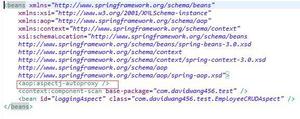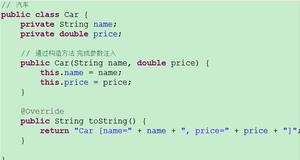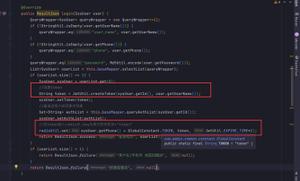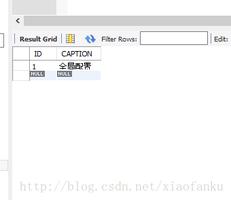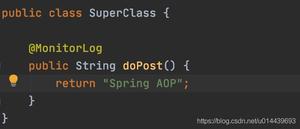Spring Aop基于注解的实现
本文内容纲要:
- 一.AspectOriented Programing,面向切面编程。- 二.AOP常用术语:
- 连接点(Joinpoint)
- 切点(Pointcut)
- 增强(Advice)
- 切面(Aspect)
- 注解切面类例子:
- 三.常用注解:
- 四.常用的@AspectJ形式Pointcut表达式的标志符:
- execution:
- within:
- @annotation
- 五.一个完整的Spring AOP的小例子:
一.AspectOriented Programing,面向切面编程。
AOP主要用于日志记录,性能统计,安全控制(权限控制),事务处理,异常处理等。将日志记录,性能统计,安全控制,事务处理,异常处理等代码从业务逻辑代码中划分出来,通过对这些行为的分离,我们希望可以将它们独立到非指导业务逻辑的方法中,进而改变这些行为的时候不影响业务逻辑的代码。
Spring AOP织入增强(Advice)的方式有两种 如果连接点实现了接口采用jdk自带的动态代理的形式实现织入,如果连接点没有实现接口则采用动态字节码生成技术(CGLIB)实现织入。
二.AOP常用术语:
连接点(Joinpoint)
增强程序执行的某个特定位置(要在哪个地方做增强操作)。Spring仅支持方法的连接点,既仅能在方法调用前,方法调用后,方法抛出异常时等这些程序执行点进行织入增强。
切点(Pointcut)
切点是一组连接点的集合。AOP通过“切点”定位特定的连接点。通过数据库查询的概念来理解切点和连接点的关系再适合不过了:连接点相当于数据库中的记录,而切点相当于查询条件。
增强(Advice)
增强是织入到目标类连接点上的一段程序代码。表示要在连接点上做的操作。
切面(Aspect)
切面由切点和增强(引介)组成(可以包含多个切点和多个增强),它既包括了横切逻辑的定义,也包括了连接点的定义,SpringAOP就是负责实施切面的框架,它将切面所定义的横切逻辑织入到切面所指定的链接点中。
注解切面类例子:
@Aspectpublic class LogAspect {
@Pointcut("execution(* com.ctj.service.*.*(..))")
public void pointcutName(){}
@Before("pointcutName()")
public void performance(){
System.out.println("Spring AOP");
}
}
三.常用注解:
- @aspect 定义切面
- @pointcut 定义切点
- @before 标注Before Advice定义所在的方法
- @afterreturning 标注After Returning Advice定义所在的方法
- @afterthrowing 标注After Throwing Advice定义所在的方法
- @after 标注 After(Finally) Advice定义所在的方法
- @around 标注Around Advice定义所在的方法
我们如何在定义切点(Pointcut)的时候指定一类Joinpoint呢?有两种方式 简单的方法名指定以及正则表达式两种方式。
四.常用的@AspectJ形式Pointcut表达式的标志符:
execution:
Spring AOP仅支持方法执行类型的Joinpoint 所以execution将会是我们用的最多的标志符,用它来帮我们匹配拥有指定方法前面的Joinpoint。匹配规则如下:
execution(modifiers-pattern? return-type-pattern declaring-type-pattern? name-pattern(param-pattern) throws-pattern)
- modifiers-pattern 修饰符 比如public private这种(可以指定可以不指定)
- return-type-pattern 返回值类型(必须指定)
- declaring-type-pattern 类型(可以是含包名的全路径类型 可以指定可以不指定)
- name-pattern 方法名(必须指定)
- param-pattern 参数类型(必须指定)
方法的返回类型 方法名及参数部分的匹配模式是必须指定的 其他部分可以省略。
我们还可以在表达式中使用两种通配符:*和..
第一:*可以用于任何部分的匹配模式中,匹配相邻的多个字符,即一个Work 。如果放在了方法参数的位置标示参数是任何类型的。
例如:execution(* *(String))
第二:..通配符可以在两个位置使用 一个是declaring-type-pattern的位置,一个是在方法参数匹配模式的位置。
如果是放在了方法类型的位置,可以指定多个层次的类型声明。例如:
execution(void cn.spring.*.doSomething(*)) 指定到cn.spring下的所有类型。
如果是放在了方法参数的匹配位置,则表示该方法可以有0到多个参数。例如:
execution(void *.doSomething(..))
within:
within标志符只接受类型声明,它将匹配指定类型下所有的Joinpoint。
例如:within(cn.spring.aop.target.*) 将会匹配 cn.spring.aop.target包下所有类型的方法级别的Joinpoint。
@annotation
使用@annotation标志符会检查系统中所有对象的所有方法级别Joinpoint,如果被检测的方法标注有@annotation标志符所指定的注解类型,那么当前方法所在的Joinpoint将被Pointcut表达式匹配。例如:@pointcut("@annotation(com.test.aop.log.ALog)") 匹配所有使用了ALog注解的方法。
匹配表达式的维度有很多 上面只是一小部分常用的,并且这些维度是可以组合的 使用||或者$$等等
例如:@around("within(com.test.finance..*) &&@annotation(com.test.finance.platform.intf.base.db.ReadOnly)")
在定义Advice的时候 我们匹配的维度可以直接写定义有@pointcut的方法名称 也可以直接使用定义@joinpoint的那一套东西来直接定义要在哪些地方织入(可以直接在Advice上指定匹配哪些方法)
定义完切面之后我们要在spring中注册这个切面类,为了让spring能自动帮我们实现织入 我们还需要开启自动注入 在spring配置文件中:<aop:aspectj-autoproxy proxy-target-class="true"/> 这样spring就能在IOC容器找到所有要织入的方法 动态帮我们织入。
五.一个完整的Spring AOP的小例子:
业务类代码:
package com.ctj.service;import org.springframework.stereotype.Service;
@Service
public class BusinessService {
public void say(){
System.out.println("Business Code");
}
}
切面类定义:
package com.ctj.aspect;import org.aspectj.lang.annotation.Aspect;
import org.aspectj.lang.annotation.Before;
import org.aspectj.lang.annotation.Pointcut;
@Aspect
public class LogAspect {
@Pointcut("execution(* com.ctj.service.*.*(..))")
public void pointcutName(){}
@Before("pointcutName()")
public void performance(){
System.out.println("Spring AOP");
}
}
spring-aop.xml
<?xml version="1.0" encoding="UTF-8"?><beans xmlns="http://www.springframework.org/schema/beans"
xmlns:aop="http://www.springframework.org/schema/aop"
xmlns:xsi="http://www.w3.org/2001/XMLSchema-instance"
xsi:schemaLocation="http://www.springframework.org/schema/beans http://www.springframework.org/schema/beans/spring-beans-3.1.xsd
http://www.springframework.org/schema/aop http://www.springframework.org/schema/aop/spring-aop-3.1.xsd">
<aop:aspectj-autoproxy proxy-target-class="true"/>
<bean id="logAspect" class="com.ctj.aspect.LogAspect">
</bean>
</beans>
基于注解的Spring AOP需要JDK1.5版本以后才能使用,之前的版本需要使用基于Schema也就是配置文件的形式来实现,如果jdk版本高的话 建议还是使用注解的形式。
本文内容总结:一.AspectOriented Programing,面向切面编程。,二.AOP常用术语:,连接点(Joinpoint),切点(Pointcut),增强(Advice),切面(Aspect),注解切面类例子:,三.常用注解:,四.常用的@AspectJ形式Pointcut表达式的标志符:,execution:,within:,@annotation,五.一个完整的Spring AOP的小例子:,
原文链接:https://www.cnblogs.com/wuwuyong/p/13234765.html
以上是 Spring Aop基于注解的实现 的全部内容, 来源链接: utcz.com/z/296900.html

